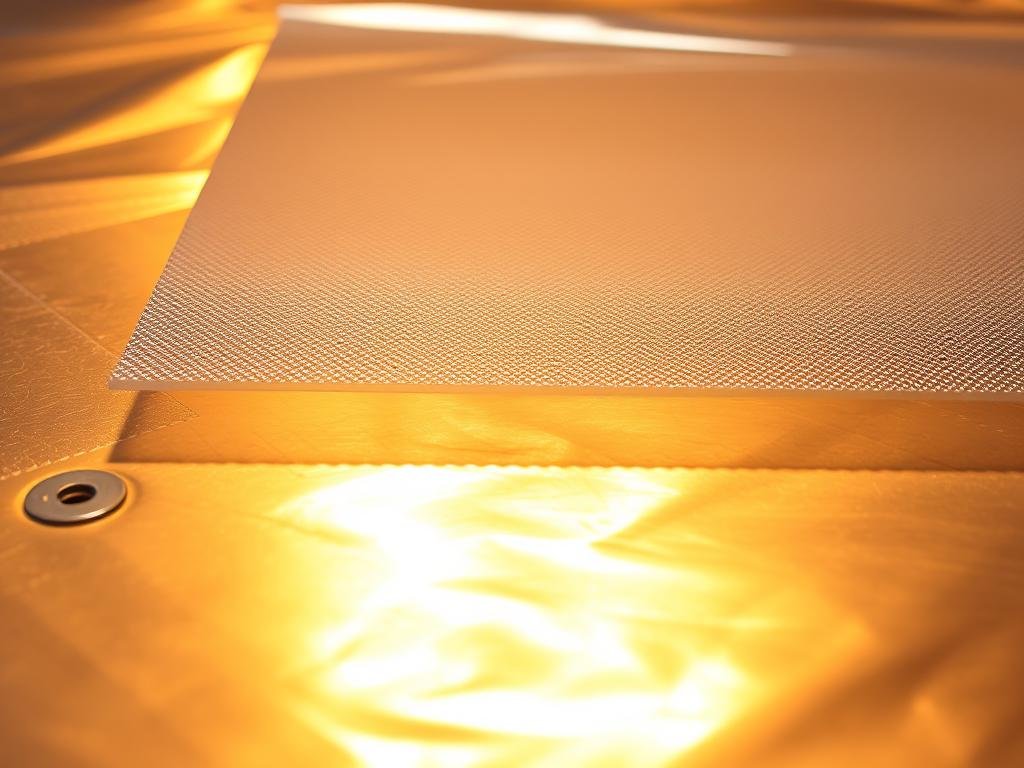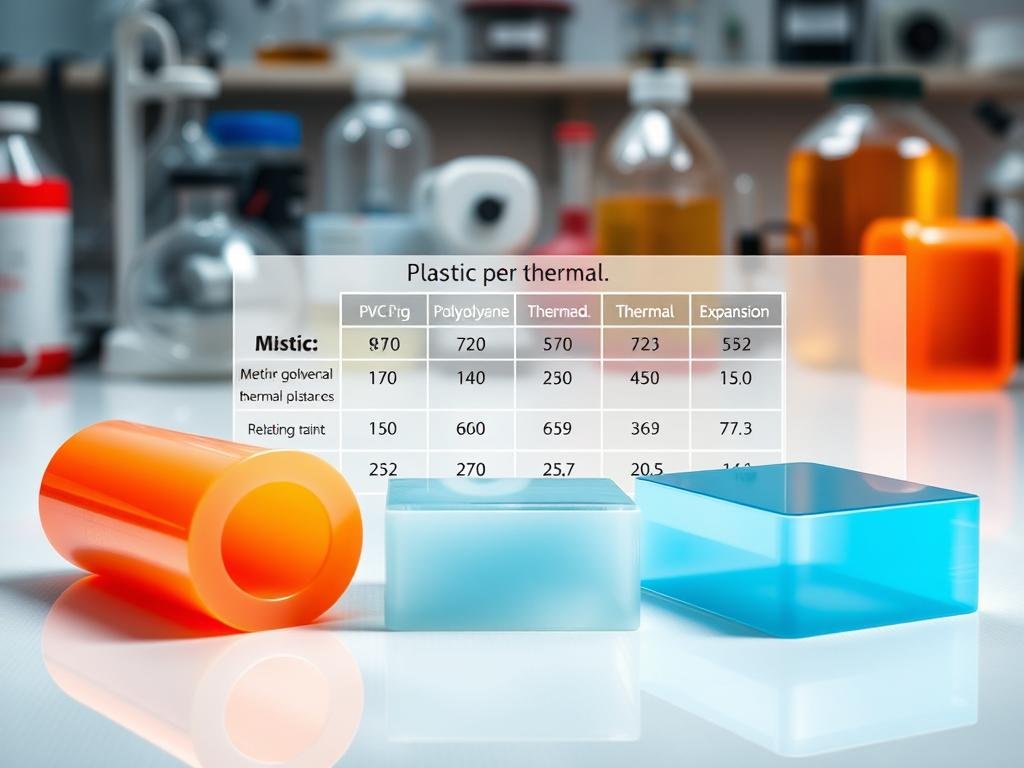Polyvinylchlorid, allgemein bekannt als PVC, is a versatile thermoplastic used in various industrial and commercial sectors. Its Schmelzpunkt ranges between 160°C and 210°C, typically around 170°C for vinyl flooring, facilitating effective thermoplastic processing.
This comprehensive guide explores the Temperatur behavior of PVC, providing essential information for professionals working with this material. Understanding PVC’s unique molecular structure and its thermal Eigenschaften is crucial for selecting the right material and processing parameters, ensuring the longevity of PVC products in various Anwendungen under different Wärme Bedingungen.
By examining the different types of PVC, including rigid and flexible PVC, and their respective thermal behaviors, readers can make informed decisions about which type is suitable for specific uses.
Understanding PVC: Composition and Basic Properties
To comprehend the melting point of PVC, it’s essential to understand its composition and basic properties. PVC, or Polyvinyl Chloride, is a type of plastic that is widely used due to its versatile properties.
What is Polyvinyl Chloride?
Polyvinyl Chloride, commonly referred to as PVC, is a synthetic polymer made from the polymerization of vinyl chloride monomers. It is a thermoplastic material, meaning it can be melted and reformed multiple times without undergoing significant chemical change. This property makes PVC highly versatile for various applications, from construction materials to medical devices.
Physical and Chemical Properties of PVC
PVC exhibits a range of physical and chemical properties that contribute to its durability and resistance. Its physical properties include a density of 1.35-1.45 g/cm³, tensile strength of 40-50 MPa, and hardness of 80-90 Shore D. These properties contribute to its structural integrity in various applications.
PVC is also known for its exceptional chemical resistance to acids, bases, salts, and many solvents, making it a preferred material for chemical storage and transport applications. Additionally, PVC has electrical insulation properties, durability factors such as resistance to weathering and UV radiation (with proper additives), and relatively low thermal conductivity (0.16-0.19 W/m·K).
The Melting Point of PVC Explained
The thermal properties of PVC, particularly its melting point, play a crucial role in its processing and application. PVC is a versatile material used in a wide range of industries, from construction to medical devices. Understanding its melting behavior is essential for optimizing its use.
Temperature Range for Different PVC Types
The melting point of PVC varies depending on its type and composition. Generally, PVC has a melting point between 100°C to 260°C. Unplasticized PVC (uPVC) tends to have a higher melting point compared to plasticized PVC. The temperature range for different PVC types is influenced by their crystallinity and the presence of additives.
| PVC Type | Schmelzpunktbereich (°C) |
|---|---|
| uPVC | 200-260 |
| Plasticized PVC | 100-200 |
Factors Affecting PVC’s Melting Point
Several factors influence PVC’s melting point, including its molecular weight distribution, degree of polymerization, and the presence of additives. The crystallinity of PVC also affects its melting behavior, with higher crystallinity resulting in higher melting temperatures. Additionally, plasticizers lower the melting point by increasing chain mobility.
Other additives, such as stabilizers and fillers, can modify PVC’s thermal properties. The manufacturing process, including thermal treatment and controlled cooling rates, also impacts the final melting characteristics of PVC products.
Rigid vs. Flexible PVC: Thermal Behavior Differences
Understanding the differences in thermal behavior between rigid and flexible PVC is essential for various applications. The distinction between these two forms of PVC is crucial due to their different responses to heat.
uPVC (Unplasticized PVC) Thermal Properties
uPVC, or unplasticized PVC, exhibits high rigidity and resistance to heat distortion. It has a relatively high softening point, typically around 80-85°C. This property makes uPVC suitable for applications requiring dimensional stability under heat, such as in construction and plumbing.
| Eigentum | uPVC |
|---|---|
| Softening Point | 80-85°C |
| Thermische Stabilität | Hoch |
Plasticized PVC Thermal Characteristics
Plasticized PVC, on the other hand, contains additives that enhance its flexibility. The addition of plasticizers significantly alters its response to heat compared to uPVC. Plasticized PVC typically has a lower softening point, beginning around 50-60°C, but remains flexible at much lower temperatures.
- The type and concentration of plasticizers affect thermal properties, with higher plasticizer content resulting in lower softening temperatures and greater flexibility.
- Plasticized PVC is used in applications such as flexible water hoses, medical tubing, and wire insulation, where resistance to heat while maintaining flexibility is crucial.
“The flexibility of PVC allows hoses to conform to tight bend radii and resist vibration or movement without cracking or leaking.”
The thermal aging behavior of plasticized PVC is also a consideration, as exposure to elevated temperatures over time can lead to plasticizer migration and changes in material properties.
Heat Resistance Capabilities of PVC
Understanding PVC’s thermal properties is essential for ensuring its safe use under different temperature conditions. PVC’s heat resistance capabilities play a significant role in determining its suitability for various applications.
Glass Transition Temperature vs. Melting Point
The glass transition temperature (Tg) of PVC marks the point at which it transitions from a brittle, glassy state to a more flexible, rubbery state. For PVC, this temperature is typically around 80°C to 85°C (176°F to 185°F). Unlike some other polymers, PVC does not have a distinct melting point; instead, it begins to soften and deform as it approaches its decomposition temperature.
Maximale sichere Betriebstemperaturen
Schedule 40 PVC can generally withstand temperatures up to around 60°C to 65°C (140°F to 149°F) for continuous use. Exceeding these temperatures, especially under high pressure, can lead to pipe bursting and the leaching of harmful substances. For applications involving higher temperatures, such as hot water heaters, materials like CPVC or PEX are more suitable due to their enhanced heat resistance and Haltbarkeit
Specialty PVC formulations like CPVC can safely operate at temperatures up to 95°C (203°F), making them ideal for hot water applications. The interaction between pressure and temperature is critical in PVC applications, as increased pressure reduces the maximum safe operating temperature.
Safety Concerns When PVC is Heated
The safety concerns associated with heated PVC are multifaceted and require careful consideration. When PVC is exposed to high temperatures, it can undergo thermal degradation, leading to the release of harmful substances.
Thermal Degradation Process
Thermischer Abbau tritt auf, wenn PVC über seinen empfohlenen Temperaturbereich hinaus erhitzt wird, typischerweise zwischen 170°C und 190°C (338°F bis 374°F). Wenn die Temperatur zu hoch ist oder das Material zu lange im Zylinder verbleibt, kann PVC zerfallen, wobei Salzsäure freigesetzt wird und schwarze Streifen oder verbrannte Stellen auf den geformten Teilen entstehen.
Potential Hazards and Precautions
Die potenziellen Gefahren im Zusammenhang mit erhitztem PVC umfassen die Freisetzung von Chlorwasserstoffgas, das schwere Atemwegsreizungen und chemische Verbrennungen verursachen kann. Um diese Risiken zu minimieren, ist es unerlässlich, geeignete Belüftungssysteme zu installieren, die Temperatur genau zu überwachen und persönliche Schutzausrüstung zu verwenden. Das Erkennen von Anzeichen für Überhitzung von PVC, wie Verfärbungen oder sichtbare Dämpfe, sowie sofortiges Handeln sind entscheidend. Eine angemessene Schulung des Personals, das mit erhitztem PVC arbeitet, ist ebenfalls wichtig, um sicherzustellen, dass sie die Risiken verstehen und die notwendigen Maßnahmen ergreifen können. Sicherheitsprotokolle.
PVC vs. Andere gängige Kunststoffe: Vergleich der thermischen Eigenschaften
Der Vergleich der thermischen Eigenschaften von PVC mit anderen Kunststoffen ist entscheidend, um das am besten geeignete Material für eine bestimmte Anwendung zu identifizieren. Die einzigartigen Eigenschaften von PVC, wie seine Feuerbeständigkeit und Chemikalienbeständigkeit, machen es zu einer bevorzugten Wahl in verschiedenen Branchen.
Vergleich von PVC mit PE, PS und PP
Beim Vergleich von PVC mit anderen gängigen Kunststoffen wie PE (Polyethylen), PS (Polystyrol) und PP (Polypropylen) spielen mehrere Faktoren eine Rolle. PVC bietet im Allgemeinen eine bessere Feuerbeständigkeit als PE und PP, und es hat eine höhere chemische Beständigkeit im Vergleich zu PS. Allerdings ist seine Temperaturbeständigkeit niedriger als die von CPVC, was seine Verwendung in Hochtemperaturanwendungen einschränkt.

Wann man PVC gegenüber anderen Materialien wählen sollte
PVC ist die optimale Materialwahl für Anwendungen, bei denen die einzigartige Kombination von Eigenschaften vorteilhaft ist. Zum Beispiel in chemischen Verarbeitungsausrüstungen und Außenbaumaterialien macht PVCs Beständigkeit gegen Chemikalien und Witterungseinflüsse es überlegen. Darüber hinaus machen die Kosteneffizienz und Haltbarkeit von PVC es zu einer bevorzugten Wahl für langfristige Infrastrukturprojekte wie unterirdische Entwässerungs- und Kanalsysteme.
- PVC wird aufgrund seiner Feuerbeständigkeit und Chemikalienbeständigkeit in chemischen Verarbeitungsausrüstungen gewählt.
- Seine Haltbarkeit und Kosteneffizienz machen es ideal für Infrastrukturprojekte.
- Für Warmwasserinstallationen sind Materialien wie CPVC oder PEX aufgrund ihrer höheren Temperaturbeständigkeit besser geeignet.
Anwendungen, bei denen die thermischen Eigenschaften von PVC eine Rolle spielen
Die thermischen Eigenschaften von PVC spielen eine entscheidende Rolle in verschiedenen Anwendungen, von der Bauindustrie bis hin zu industriellen Einsatzmöglichkeiten. Die Fähigkeit des Materials, unterschiedlichen Temperaturen standzuhalten, beeinflusst seine Leistung und Haltbarkeit in verschiedenen Umgebungen.
Bau- und Sanitäranwendungen
Im Bau- und Sanitärbereich wird PVC aufgrund seiner thermischen Stabilität und Wasserbeständigkeit häufig verwendet. PVC-Rohre sind ideal für Wasserversorgungssysteme, da sie ihre strukturelle Integrität bei verschiedenen Temperaturbedingungen beibehalten. Die Temperaturbeständigkeit des Materials stellt sicher, dass es langlebig und dicht bleibt, was es zu einer bevorzugten Wahl für Sanitäranwendungen macht.
Industrielle und gewerbliche Anwendungen
In industriellen Umgebungen sind die thermischen Eigenschaften von PVC entscheidend für seine Verwendung in chemischen Verarbeitungsausrüstungen und elektrischer Isolierung. Die Fähigkeit von PVC, moderaten Temperaturen zu widerstehen und seine Isoliereigenschaften beizubehalten, macht es geeignet für Kabelummantelungen. Zusätzlich ist die thermische Stabilität von PVC in industriellen Bodenbelagsanwendungen vorteilhaft, wo es moderaten Temperaturschwankungen und gelegentlicher chemischer Exposition standhält. Der Herstellungsprozess profitiert ebenfalls von den thermischen Eigenschaften von PVC, da sie das Design und die Installation industrieller Komponenten wie Ventile und Tanks beeinflussen.
| Anwendung | Temperature Consideration | Vorteil von PVC |
|---|---|---|
| Wasserversorgungssysteme | Widerstand gegen Temperaturschwankungen | Langlebig und auslaufsicher |
| Chemische Verarbeitungsausrüstung | Angemessene Temperaturbeständigkeit | Handhabt ätzende Substanzen effektiv |
| Industrieller Bodenbelag | Thermal stability | Langlebig in Umgebungen mit mäßigen Temperaturschwankungen |
Fazit: Informierte Entscheidungen über PVC und Hitze
Beim Arbeiten mit PVC ist das Verständnis seiner thermischen Eigenschaften entscheidend, um Sicherheit und Qualität in verschiedenen Anwendungen zu gewährleisten. Der Schmelzpunkt von PVC liegt zwischen 160-210°C, und seine Glasübergangstemperatur liegt zwischen 70-90°C. Die maximale Dauergebrauchstemperatur für Standard-PVC-Formulierungen beträgt in der Regel 60-65°C.
Um fundierte Entscheidungen über die Verwendung von PVC zu treffen, berücksichtigen Sie sowohl die maximalen Temperaturen, denen es ausgesetzt wird, als auch die Dauer dieser Exposition. Zum Beispiel ist die Aufrechterhaltung einer konstanten Temperatur zwischen 170°C und 190°C ideal für die PVC-Spritzgießung, da sie einen guten Fluss ermöglicht, ohne das Material zu gefährden.
Während PVC in Hochtemperaturumgebungen Einschränkungen hat, macht seine einzigartige Kombination von Eigenschaften, einschließlich chemischer Beständigkeit, Haltbarkeit und Kosteneffizienz, es zu einer ausgezeichneten Wahl für viele Anwendungen, wenn es innerhalb seines geeigneten Temperaturbereichs verwendet wird. Durch das Verständnis des thermischen Verhaltens von PVC und die Einhaltung einer angemessenen Temperaturkontrolle können Nutzer seine Vorteile maximieren und potenzielle Gefahren minimieren.
